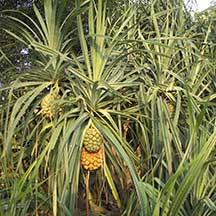 |
|
|
plants text index | photo
index
|
| coastal plants |
| Mengkuang
or Seashore
pandan Pandanus tectorius Family Pandanaceae updated Jan 13 Where seen? With long prickly leaves, this plant is hard to ignore when you are trying to push your way through vegetation near the shore. It is still commonly seen on undisturbed shores and back mangroves. In the past, it was common along sandy shores in many parts of Singapore. It is probably the most widespread Pandanus species, being cultivated for its many uses. It is found on all tropical shores and throughout Southeast Asia. Its old name P. odoratissimus is an accepted synonym. Features: A prickly tall bush (2-3m) to a small tree (3-14m tall), widely branching sometimes with several trunks which can be spiny. Often with stilt roots around the stem. Also emerging from the stems, aerial roots with 'warts' and conspicuously large root ‘caps’. Leaves long, strap-like (70cm-2.5m) with pointed tip and sharp wicked spines along the sides and midrib on the underside, leaves arranged in a spiral. Shiny green upperside, dull on the underside. Dead leaves hang down like a skirt and eventually fall away. According to Little, male and female plants have different structures. Trunks of male trees are hard and solid throughout. The timber is yellow, strong and difficult to split. Trunks of female trees have a hard outer part, but soft inner pith. In fact, the trunks of female trees have used as water pipes after removal of the pith. The male flowers form a pendulous ‘cone’ (25-60cm) comprising many small flowers. Around the male flowers are yellow-white leaflets that produce a pleasant smell. The female flowers emerge as compact greenish egg-shaped heads with pistils densely crowded with colored scales. Each fruit (4-20cm wide, 8-30cm long), hard and fibrous, containing usually 5-11 seeds. The fruits form an egg-shaped compound fruit that looks like a pineapple. Green ripening orange. The fruits float and can remain viable for a long time as they disperse with the sea. Some accounts suggest animals also disperse the seeds of those varieties with sweet pulp. Human uses: According to Burkill, many varieties are widely cultivated for various purposes. Each cultivated variety has different uses, e.g., for making mats, for the fruits and so on. Up to 28 varieties of this plant have been described. It is important to traditional coastal dwellers particularly in the Pacific. The leaves are widely used to make matting, bags. To prepare the leaves for weaving into mats, they are first split down the midle to remove the spiny midrib, then cut into strips by dragging them over a board with brass spikes in it. The strips are softened by pulling them over a bamboo and pounding them withe a pestle, then soaked for three days with changes in water. The strips are then bleached in the sun before they are woven into mats, cords, sugar bags, hats and in the past, even boat sails. The sweet smelling male flowers are used by women in their hair or to prepare scented oils. Medicinal uses include using the young leaves as an antidote for poisoning. |
 Can grow into a tall tree! Pulau Semakau, May 07  Pulau Semakau, Oct 05  Compound fruit that resembles a pineapple. Pulau Semakau, May 07 |
 Female flower a green gloobular cone. Lazarus, Apr 12 |
 Male flowers. |
 Male flowers tiny white in a long cone. Pulau Semakau, Mar 09 |
Seashore
pandan on Singapore shores
| Photos for free download from wildsingapore flickr |
|
Links
References
|
|
|